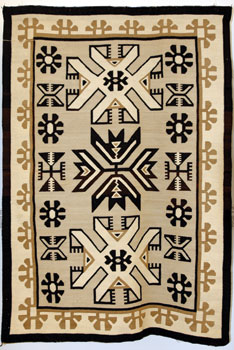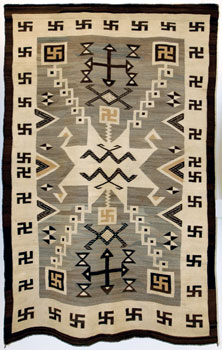Toadlena/Two Grey Hills Weaving
|
The Navajo people, or Diné as they call themselves, will tell you that Spider Woman taught them to weave a long time ago and that Spider Man made them looms of sky and earth, crystal, sunbeams, and lightning to weave on. Historians and anthropologists will tell you that they most likely learned from some of their Pueblo neighbors, already accomplished cotton weavers, who fled from the Spanish occupation of their lands and took refuge with the Diné. Whatever the true source, historic Spanish documents from the late eighteenth century tell us that Catholic mendicants encountered Navajo woven products in their travels.
In 1890, a fellow by the name of Joe Wilkins started a trading outpost at a place called Crystal on the west side of the Chuska Mountains in New Mexico. It was not the first such establishment on the reservation. About a dozen enterprising men had already established trading posts among the Navajo beginning with a Mormon trading operation at Lee’s Ferry on the Colorado River in 1874. Wilkins sold his Crystal post to J.B. Moore in 1896 and moved to the east side of the Chuskas and started the Two Grey Hills post, named for its two prominent geographic landmarks. Although based in Crystal, Moore is credited as the person responsible for instigating the style of weaving that eventually evolved into Two Grey Hills/Toadlena.
The idea of promoting a regional style of Navajo weaving was not new at this time. Lorenzo Hubbell had already popularized the red Ganado style of weaving and the Noel family had successfully marketed the multi-colored Eye-Dazzler style at Teec Nos Pos. |

Image: © Esther Silentman (1903-1991)
Toadlena/Two Grey Hills Textiles
Esther was one of the Toadlena/Two Grey Hills early Master Weavers who was very active in the 1930s–1960s. She wove rugs using the last name of Gould, Jimmy, Manuelito, Taugelchee and finally Silentman
|
Unlike their more striking cousins, Crystal style rugs used natural and naturally-dyed red, blue, gray, black and white colors. What Moore did that was really different was to work directly with his weavers to continually improve the quality of their rugs. Moore introduced weavers to new designs and encouraged them to employ them in their weavings. He is credited with increasing the use of “Oriental” motifs in Navajo weaving as well as the distinctive Greek crosses and swastikas, or “whirling logs,” common to this period. He also revolutionized, but did not invent, the practice of marketing specific products through advertising leaflets and catalogs. This enabled him to successfully generate income from buyers who did not have the time or wherewithal to travel to his remote corner of the planet. In spite of his success, Moore abruptly left Crystal in 1911 under the cloud of a postal fraud scandal and was never heard from again.
After Moore fled Crystal, George Bloomfield purchased the post at Toadlena on the other side of the Chuskas and Ed Davies bought out Wilkins at Two Grey Hills. The two of them became friends and soon discovered that the local weavers were largely averse to bright colors, especially red. Two Grey Hills weavers preferred to utilize the natural shades of tan, brown, black and white that grew on the backs of the churro sheep introduced by the Spanish. The Navajos favored the churro for its hardiness as well as its relatively fine and easily spindle-spun wool with low lanolin content. Bloomfield and Davies decided to encourage their weavers to continue the practice and began scouring the reservation for more churro sheep to complement the colors of the ones found around Two Grey Hills. They soon established enough herds of sheep to provide more than a dozen different natural shades of wool for their weavers. Their efforts paid off well and today, most of the colors that are the essence of the Two Grey Hills style of weaving are only found on churro sheep confined to this small area of the Navajo reservation.
|
Like Moore, Bloomfield worked with his stable of weavers to continually improve their products; however, Bloomfield’s approach was more personalized. He took the time to go over each individual piece with every weaver and point out its strengths and weaknesses. Bloomfield encouraged his weavers to emulate the styles pioneered and popularized by Moore’s Crystal weavers. He and Davies are credited with introducing the standardized 48 by 72-inch size of Two Grey Hills rugs. Bloomfield paid good prices for each rug and often rewarded excellence with the bonus of a prized velvet blouse or a piece of jewelry.
Both Two Grey Hills and Toadlena are located west of Chaco Canyon and near several minor Pueblo ruins. Bloomfield and Davies collected pottery shards from these sites and encouraged their weavers to adopt some of the ancient Anasazi motifs and patterns in their weavings. Rugs employing these elements proved to be hugely popular and sold well. Toadlena/Two Grey Hills was also home to many excellent weavers
whose outstanding quality of work attracted many appreciative and discerning collectors. |
Perhaps the most famous of these weavers was a man named Hastiin Klah (left-handed man, sometimes spelled Hosteen Klah). Klah was already well established by the time Bloomfield and
Davies entered the scene, having risen to prominence many years earlier as a featured Navajo weaver at the 1892-93 Chicago World Colombian Exposition. A respected medicine man, Klah became famous during the early part of the 20th century for his woven depictions of sand paintings. His work drew the attention of Mary Cabot Wheelwright, who collected many of his weavings. Klah advised her in the design of a museum in Santa Fe now known as the Wheelwright Museum of the American Indian. Unfortunately, Klah did not live long enough to witness the opening of the museum.
The progression of the quality of Toadlena/Two Grey Hills rugs from 1920 to the present is quite striking. The patterns and motifs remain based upon many of the original concepts introduced by Moore, Bloomfield, and Davies and complexity of the designs has waxed and waned; but over the years rugs from this area have evolved into the realm of fine art. Weavers have begun employing finer and finer spun wool and the weavings have grown much tighter. Today, most of the pieces are much smaller than the standardized 48 by 72-inch size introduced by Bloomfield as the time necessary to produce a large piece with such quality can take years. These smaller, finer pieces are often called tapestry weavings.
|

Weaver unknown ca 1920
This early Storm Pattern Two Grey Hills rug has lightening bolts which reach out to the four sacred mountains, as seen in the corners of the field of the rug. The swastika, or whirling logs design was commonly used in this period.
|
|
Today, the Toadlena Trading Post is owned and operated by Mark Winter and the Two Grey Hills Trading Post by Les Wilson. Weaving is experiencing a renaissance of sorts in this area and many Navajo men and women are producing increasing amounts of exceedingly fine tapestry-style weavings. They are highly prized by collectors who come from the far corners of the world to sample and purchase the exquisite wares of these ingenious fiber artists of the people called Diné.
To learn more about Navajo weaving, trading posts, and Toadlena/Two Grey Hills weavings in particular, read Marian Rodee’s Old Navajo Rugs, University of New Mexico Press, Albuquerque, 1981; Mark Winter’s Dancing With Wool, Toadlena Trading Post Press, 2002; or visit the Wheelwright Museum of the American Indian and the Museum of Indian Art and Culture in Santa Fe or take a drive out to the Chuskas and visit the Toadlena Trading Post Museum and the Two Grey Hills Trading Post just west of Newcomb, NM. To learn about Hastiin Klah, read Franc Newcomb’s Hosteen Klah: Navaho Medicine Man and Sand Painter, University of Oklahoma Press, new edition 1980.
Thanks to Claude Stephenson, Ph.D, who is the State Folklorist for the State of New Mexico.
Originally appeared in The Collector’s Guide to Santa Fe, Taos & Albuquerque – Vol 22 |
|


